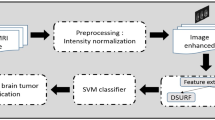Abstract
For effective diagnosis of health conditions, there is a need to process medical images to obtain meaningful information. The diagnosis of brain tumors begins with magnetic resonance imaging (or MRI) scan. This is followed by segmentation of the medical images so obtained which can prove cumbersome if it were to be performed manually. Determining the best approach to do segmentation remains challenge among multiple computerized approaches. This paper combines both the identification and classification of tumors from the MRI results and is backed by a cloud-based framework to provision the same. The phase of extraction of features includes the utilization of a Hadoop framework and Gabor filter along with variations in terms of orientation and scale. Artificial bee colony algorithm and support vector machine classifier have been used to designate the degree of optimal features and categorize the same. The grading of brain tumors from MRI images can be fulfilled by the aforementioned approach. The said approach is believed to deliver promising results in terms of accuracy, which has also been verified experimentally.





Similar content being viewed by others
References
Clausi DA, Deng H (2005) Design-based texture feature fusion using Gabor filters and co-occurrence probabilities. IEEE Trans Image Process 14(7):925–936
Dogra J, Jain S, Sood M (2018) Segmentation of MR images using hybrid kmean-graph cut technique. Procedia Comput Sci 132:775–784
Gholami R, Fakhari N (2017) Support vector machine: principles, parameters, and applications. In: Handbook of neural computation. Academic Press, pp 515–535
Greeshma L, Pradeepini G (2016) Big data analytics with Apache Hadoop mapreduce framework. Indian J Sci Technol 9(26):1–5
Guenther N, Schonlau M (2016) Support vector machines. Stata J 16(4):917–937
Hasan A et al (2016) Segmentation of brain tumors in MRI images using three-dimensional active contour without edge. Symmetry 8(11):132
Lalaoui L, Mohamadi T, Djaalab A (2015) New method for image segmentation. Procedia Soc Behav Sci 195:1971–1980
Sauwen N et al (2016) Comparison of unsupervised classification methods for brain tumor segmentation using multi-parametric MRI. NeuroImage Clin 12:753–764
Sehgal D, Agarwal AK (2018) Real-time sentiment analysis of big data applications using Twitter data with Hadoop framework. In: Soft computing: theories and applications. Springer, Singapore, pp 765–772
Shah JA, Suralkar SR et al (2016) Brain tumor detection from MRI images using fuzzy C-means segmentation. Int J Adv Res Comput Commun Eng 5:178–183
Smistad E, Falch TL, Bozorgi M, Elster AC, Lindseth F (2015) Medical image segmentation on GPUs—a comprehensive review. Med Image Anal 20:1–18
Sowjanya V, Rao GS, Sarvani A (2016) Investigation of optimal wavelet techniques for de-noising of MRI brain abnormal image. Procedia Comput Sci 85:669–675
Xuan X, Liao Q (2007) Statistical structure analysis in MRI brain tumor segmentation. In: Fourth international conference on image and graphics (ICIG 2007). IEEE, pp 421–426
Xue Y, Jiang J, Zhao B, Ma T (2018) A self-adaptive artificial bee colony algorithm based on global best for global optimization. Soft Comput 22(9):2935–2952
Zhang Y, Brady M, Smith S (2001) Segmentation of brain MR images through a hidden Markov random field model and the expectation–maximization algorithm. IEEE Trans Med Imaging 20(1):45–57
Author information
Authors and Affiliations
Corresponding author
Ethics declarations
Conflict of interest
All authors declare that they have no conflict of interest.
Additional information
Communicated by V. Loia.
Publisher's Note
Springer Nature remains neutral with regard to jurisdictional claims in published maps and institutional affiliations.
Rights and permissions
About this article
Cite this article
Aruna, S.K., Sindhanaiselvan, K. & Madhusudhanan, B. Computerized grading of brain tumors supplemented by artificial intelligence. Soft Comput 24, 7827–7833 (2020). https://doi.org/10.1007/s00500-019-04403-7
Published:
Issue Date:
DOI: https://doi.org/10.1007/s00500-019-04403-7




